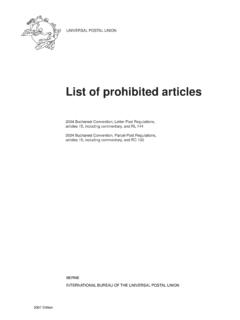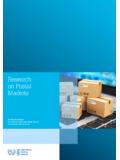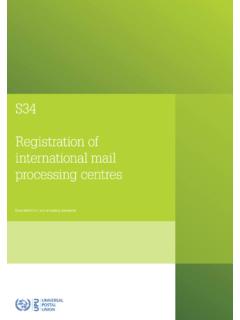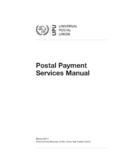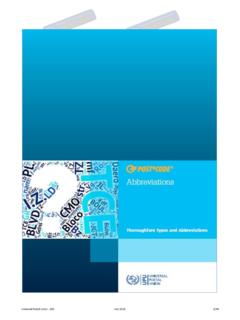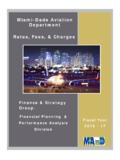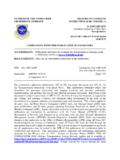Transcription of Statistics and Accounting Guide - Universal Postal …
1 Statistics and Accounting Guide January 2017 edition Contact: Mr Philippe Grondein Remuneration Programme Markets Development and Regulation Directorate UPU International Bureau This version of the Guide includes changes to the UPU Convention decided upon by the 2012. Congress, as well as changes to the Letter Post Regulations decided upon by the Postal Operations Council up to February 2016. 3. Table of contents Page CHAPTER I terminal DUES RATES AND TRANSIT charges .. 5. 1 THE terminal DUES 5. Rates Target system .. 5. Rates New target system .. 7. Rates Transitional system .. 7. Exchange of format-separated mails .. 8. Accession to the target system .. 9. Registered and insured items .. 9. M bags .. 9. Contributions to the Quality of Service Fund (QSF) .. 9. Bulk 10. Link to quality of service .. 11. Direct access .. 13. International business reply service (IBRS) .. 13. Advice of delivery service (AR).
2 14. 2 TRANSIT: CONVEYANCE AND 14. Conveyance to the country of destination .. 14. Transit of d couvert items and missent items .. 15. Return of empty bags .. 17. 3 EXEMPTION FROM terminal DUES .. 19. CHAPTER II STATISTICAL OPERATIONS RELATED TO terminal DUES .. 20. 1 INTRODUCTION .. 20. The target country system .. 20. The revision mechanism .. 20. 2 OVERVIEW OF THE STATISTICAL PROCESS .. 22. General principles .. 22. Sample selection for target system DOs (RL 229) .. 22. Sample selection for the revision mechanism (RL 232) .. 26. Data collection .. 29. Estimation overview .. 31. Notice of design decisions .. 32. Statistical counts not performed .. 32. CHAPTER III terminal DUES SYSTEM OPERATIONS AND Accounting .. 43. 1 OPERATIONS CONCERNING REGISTRATION OF WEIGHT AND NUMBER OF ORDINARY MAIL AND REGISTERED AND INSURED ITEMS. SUBJECT TO terminal DUES .. 43. Operations at the office of exchange of origin CN 31 letter bill.
3 43. Procedures for returning empty bags .. 45. Operations at the office of exchange of destination .. 45. Operations at the central service of the designated operator of destination .. 46. 2 OPERATIONS CONCERNING BULK MAIL .. 47. Operations at the office of exchange of 47. Operations at the office of exchange of destination .. 47. Accounting for bulk mail .. 48. 3 Accounting FOR terminal DUES .. 48. CN 61 detailed account .. 48. Time limit for submission of CN 49. Time limit for acceptance of CN 61 .. 49. 4 SETTLEMENT OF terminal DUES ACCOUNTS .. 49. CN 64 statement .. 49. Time limit for acceptance of CN 64 .. 49. 5 PROVISIONAL PAYMENTS OF terminal 50. When and on what basis a provisional payment may be requested .. 50. Exchange rate to be 50. 6 QUALITY OF SERVICE FUND Accounting .. 50. 4. Regular billing .. 50. Time limit for payment .. 51. CHAPTER IV TRANSIT OPERATIONS AND Accounting .
4 60. 1 REGISTRATION OF THE WEIGHT OF MAIL SUBJECT TO CLOSED TRANSIT charges AND OF EMPTY RECEPTACLES .. 60. Operations at the office of exchange of 60. Operations at the office of exchange of transit .. 60. 2 DETERMINATION OF THE WEIGHT OF EMPTY 61. CN 69 "empty receptacles" statements .. 61. 3 DETERMINATION OF THE WEIGHT OF D COUVERT (OPEN TRANSIT) ITEMS .. 61. Operations at the office of exchange of 61. Operations at the office of exchange of open transit .. 63. 4 PREPARATION OF DETAILED ACCOUNTS FOR TRANSIT (CLOSED AND OPEN TRANSIT) AND EMPTY BAGS .. 63. Accounting for closed transit mail surface .. 63. Accounting for closed transit mail by 64. Accounting for empty 64. Accounting for open transit 64. Accounting for internal air conveyance .. 65. Submission and acceptance of CN 51 accounts .. 65. 5 SETTLEMENT OF TRANSIT charges ACCOUNTS .. 65. Settlement .. 65. Methods of payment.
5 65. Time limit for payment .. 65. APPENDIX A STATISTICAL OPERATIONS RELATED TO terminal DUES .. 84. 1 OVERVIEW OF UPU SYSTEM SAMPLING REQUIREMENTS .. 84. Flat rate per kilogramme involving exchanges with transitional countries .. 84. Target country system .. 84. Revision mechanism .. 84. 2 FORMULAE FOR ESTIMATION OF ANNUAL IPK AND ANNUAL 85. Formula by mail category .. 85. APPENDIX B INFORMATION ON AIRMAIL 87. 1 THE BASIC AIRMAIL CONVEYANCE 87. 2 DEFINITION OF TONNE-KILOMETRE AND KG-KILOMETRE .. 87. 3 HOW WEIGHTS AND DISTANCES ARE MEASURED .. 87. 4 THE CN 38 DELIVERY 90. 5 EMPTY BAG BILLING SCENARIOS .. 93. 6 INTERNAL AIR CONVEYANCE .. 94. APPENDIX C OVERVIEW OF terminal DUES TIMELINES .. 98. APPENDIX D COUNTRY CLASSIFICATION .. 99. Notes 1 References to RL relate to the Letter Post Regulations adopted by the 2013 POC. International Bureau of the Universal Postal Union Berne, September 2013.
6 5. Chapter I terminal dues rates and transit charges 1 The terminal dues system 1 terminal dues were introduced by the 1969 Tokyo Congress as a means of compensating designated operators for the costs incurred in handling mail received ( costs relating to operations such as sorting, conveyance to the delivery office, and delivery). 2 Between the single rate applicable to all mail adopted at the Tokyo Congress and the system adopted by the 2012 Congress, several improvements had been made by successive Congresses with the aim of making the system as fair as possible. 3 Major changes in the international Postal environment have brought a certain complexity to the system because of the need to prevent it from being circumvented and exploited to the prejudice of designated operators. 4 As of 1 January 2014, when the Acts of the 25th Congress come into force, the principles of the termi- nal dues (TD) system (Convention articles 29 to 32) are as follows: a By virtue of Congress resolution C 77/2012, countries are classified in groups , , 2, 3, 4 and 5.
7 (The list of countries in each group is included in Appendix D to this Guide .): group comprises the countries in the target system prior to 2010;. group and 2 countries joined the target system as of 2010 and 2012;. group 3 countries will join the target system in 2016;. group 4 and 5 countries will apply the transitional TD system for the 2014 2017 period. b The arrangements are transitional, moving toward a country-specific payment system. c Any country in the transitional system may opt to be treated as a target country under the terminal dues provisions in the Convention and Letter Post Regulations (Convention article ). Transition countries can volunteer to be treated as target countries ( , or 2). Target countries from groups and 2 can volunteer to be treated as group countries. Target countries from group 2 can volun- teer to be treated as group countries. d Access is opened to the rates, terms and conditions for the domestic services of each country in the target system, and on a non-discriminatory basis to countries in the transitional system.
8 Rates Target system 5 Countries in the target system prior to 2010 will pay each other country-specific rates based on 70% of the domestic tariffs for a 20-gramme priority small letter (P) and a 175-gramme priority large letter (G), subject to the following caps: 2014: SDR per item and SDR per kilogramme;. 2015: SDR per item and SDR per kilogramme;. 2016: SDR per item and SDR per kilogramme;. 2017: SDR per item and SDR per kilogramme. 6 The rates may not be lower than: 2014: SDR per item and SDR per kilogramme;. 2015: SDR per item and SDR per kilogramme;. 2016: SDR per item and SDR per kilogramme;. 2017: SDR per item and SDR per kilogramme. 6. 7 Countries in the target system as from 2010 and 2012 will pay each other country-specific rates based on 70% of the domestic tariffs for a 20-gramme priority small letter (P) and a 175-gramme priority large letter (G), subject to the following caps: 2014: SDR per item and SDR per kilogramme.
9 2015: SDR per item and SDR per kilogramme;. 2016: SDR per item and SDR per kilogramme;. 2017: SDR per item and SDR per kilogramme. 8 The rates may not be lower than: 2014: SDR per item and SDR per kilogramme;. 2015: SDR per item and SDR per kilogramme;. 2016: SDR per item and SDR per kilogramme;. 2017: SDR per item and SDR per kilogramme. 9 The rates applied for flows between countries in the target system in a given year shall not lead to an increase of more than 13% in the base terminal dues revenue before quality of service adjustment for a letter-post item of grammes, compared with the previous year. 10 For flows under 75 tonnes per year between countries in the target system as from 2010 and between these countries and countries in the target system prior to 2010, the per kilogramme and per item components are converted into a total rate per kilogramme on the basis of the average of items per kilogramme.
10 11 Article RL 220 describes the steps to be followed for the calculation of the 2017 terminal dues rates using the tariffs for a 20-gramme priority small letter and for a 175-gramme priority large letter in the domes- tic service. Example of the calculation of terminal dues rates in the target system for the year 2017. 12 A designated operator in the target system prior to 2010 notifies to the UPU International Bureau (IB). the following domestic charges in force on 1 June 2016: SDR for a 20-gramme priority small letter and SDR for a 175-gramme priority large letter in the domestic service. The rates calculated for the previous year are as follows: SDR per kg and SDR per item. On the basis of this information the rates for 2017 will be determined as below: i The applicable percentage of domestic charges is 70% (article ). The minimum rates for 2017 are SDR per item and SDR per kg and the maximum rates are SDR per item and SDR per kg (article and 9).

